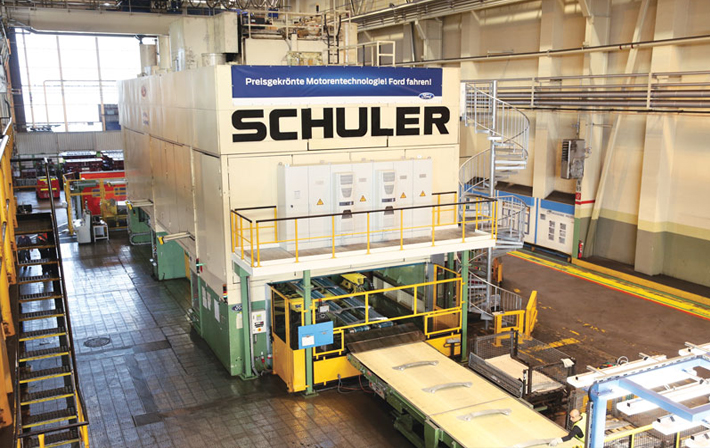Retrofit Tunes Ford Press to High Performance

The large panel press at Ford in Cologne was no longer up to date: Because the transfer was mechanically linked to the rest of the system, the motion curves could not be adjusted and the components had to be stored between the press slides.
Solution from Schuler
Schuler specializes in metal forming technology. The company supplies presses, automation solutions, dies, process know-how, and services for the metalworking industry and lightweight automotive design.
To address Ford’s issue, Schuler installed a Tri-axis Transfer with overhauling carriages as well as a blank loader with a line scanner at the press in seven weeks.
In the first six months after the modernization, the press already produced over 1.2 million parts. This is mainly due to the good cooperation between Schuler and Ford. Ford itself, with its own qualified department, brought the control of the straight-sided press to the latest level and prepared it for the installation of the new transfer. The interim storage has now become obsolete: With a servomotoric overhauling slide, which is integrated in the transfer rails, step distances of more than 3.60 m can be realized.
The coupling and uncoupling takes place automatically during the die change. This means that all necessary setup procedures can be carried out outside the press and the die changeover times can be significantly reduced. Schuler’s ProTrans features feed direct drives with highly dynamic servomotors as well as active vibration dampening. An increase in output by up to 30 percent and more is therefore not uncommon.
Thanks to the free programm-ability of the transfer, which can be controlled by its own visualization, Ford can now design new dies more flexibly and optimize on output. The dies are also easier to set up and adjust. As the profile of the transfer rails reduces from 250 to 200 mm, the freedom of movement and visibility into the die improves. And the energy supply as well as maintenance costs are reduced by the elimination of the mechanical connection to the press.


1. Schuler’s new Tri-axis Transfer takes the parts from one die to the other, the interim storage becomes obsolete.
2. Thanks to the blank loader with line scanner, productivity and process reliability improve significantly.


3. For location detection, the blank can pass below a line scanner and does not have to stop anymore.
4. The optical centering station is accurate up to 3 mm, the location can be corrected by up to 100 mm.
Continuous location detection increasecycle times
The blank loader, too, improves the productivity of the press: The exact location of a blank is detected while it is passing a line scanner; the blanks do not have to stop anymore. On basis of this information, the following centering robot can align the blanks optimally for the subsequent forming process in a press. Because the line scanner is attached right above the belt conveyor – and not at several meters in height as with conventional optical centering stations – the system is largely insensitive to ambient light passing through the ceiling window, for instance. This improves process reliability significantly.
Unlike a mechanical centering station, the system with line scanner is also completely independent of the blank shape and also protects the surface of the blank. The maintenance cost of the system is also low. The optical centering station is accurate up to 3 mm, the location in and at right angles to the transport direction can be corrected by up to 100 mm. The maximum blank size is 4,100 mm. The line scanner also captures double parts side by side as well as in a row.
Thanks to a pre-commissioning of Tri-axis transfer and blank loader with line scanner at Schuler and a well-coordinated construction site, the downtime for Ford was less than two months.
HIGHLIGHTS
Challenges
- The large panel press at Ford in Cologne was in a need of an overhaul.
- Since the transfer was mechanically linked to the rest of the system, the motion curves could not be adjusted and the components had to be stored between the press slides
Solution
- Ford installed Schuler’s Tri-axis Transfer and modernized the transfer and blank loader of its large panel press.
- The Tri-axis Transfer takes the parts from one die to the other, hence making the interim storage obsolete.
- Due to the free programmability of the transfer, which can be controlled by its own visualization, Ford can now design new dies more flexibly and optimize on output.
- With a servomotoric overhauling slide step distances of more than 3.60 m can be realized.
- Because of the blank loader with line scanner, productivity and process reliability has improved significantly.
- For location detection, the blank can pass below a line scanner and does not have to stop anymore.
- The optical centering station is accurate up to 3 mm; the location can be corrected by up to 100 mm
Source: Schuler Group





 Facebook
Facebook.png) Twitter
Twitter Linkedin
Linkedin Subscribe
Subscribe